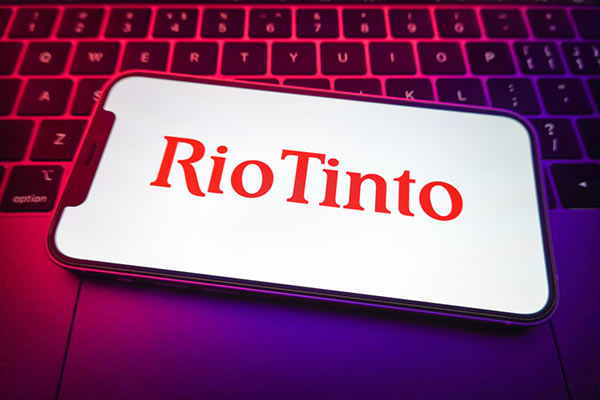ii view: mining giant Rio Tinto still confident about 2024
Producing metals used in energy transition products and trading on an attractive dividend yield. Buy, sell, or hold?
17th April 2024 11:45
by Keith Bowman from interactive investor

First-quarter production update to 31 March
- Australian Pilbara iron ore shipment of 78 million tonnes (mt), down 10% from Q4
- Mined copper of 156 kilotonnes (kt), down 3% from Q4
Chief Executive Jakob Stausholm said:
"We delivered stable operating results in the first quarter. We remained focused on growth in energy-transition materials, with the ramp-up at Oyu Tolgoi underground, the first full quarter of recycled aluminium production from Matalco and further progress at Simandou, our high grade iron ore project in Guinea.
“We continue to pursue our long-term strategy, and have a clear pathway to deliver operational excellence, while investing in profitable growth and delivering attractive shareholder returns."
- Invest with ii: SIPP Account | Stocks & Shares ISA | See all Investment Accounts
ii round-up:
Mining giant Rio Tinto Registered Shares (LSE:RIO) today detailed quarterly demand for iron ore, its biggest profit generator, broadly matching City estimates with guidance for the year ahead left unchanged.
Shipments for its Australian Pilbara iron ore fell 10% from the previous quarter to 78 million tonnes (mt), largely due to seaport weather disruption for customer deliveries, but with management estimates for a potential 2% year-over-year increase to 338 mt left unchanged.
Shares in the FTSE 100 miner rose 3% in UK trading having come into this latest news down by a tenth year-to-date. That’s better than a 15% retreat at rival BHP Group Ltd (LSE:BHP) and a more than one-fifth fall for the price of iron ore in 2024 given ongoing concerns about the economic health of its biggest customer China. The FTSE 100 index is up just over 1% this year, while Hong Kong's Hang Seng index is down nearly 5%.
Production of Rio’s second biggest profit generating commodity copper was down 3% from the previous fourth quarter to 156 kilo tonnes, hindered by unplanned conveyor downtime at its US Salt Lake City, Kennecott, operation.
The price of copper has risen around 10% year-to-date, buoyed by its use in the climate change energy transition and limited mine supply growth. Rio’s full-year production guidance stayed unchanged at 660 to 720 kt, an expected increase from 2023’s 620 kt.
Rio also continues to push greener alternatives for its own operations, with the miner recently joining forces with BHP to investigate the development of Australia's first electric smelting furnace pilot plant.
Broker Morgan Stanley reiterated its ‘overweight' stance on the shares post the update, flagging Rio as a ‘top pick’.
ii view:
Rio Tinto employs over 55,000 people across more than 30 countries, with strong presences in both Australia and North America. Headquartered in London, group rivals include Glencore (LSE:GLEN), Anglo American (LSE:AAL) and Antofagasta (LSE:ANTO). Australian Pilbara iron ore generates by far its biggest chuck of adjusted profits (EBITDA) at around three-quarters, followed by copper at around 16% and aluminium a further 10%. Copper output is being expanded via the development of its underground resource at Oyu Tolgoi, Mongolia, with iron ore operations in Guinea, West Africa, also being pushed.
For investors, concerns about the health of the global economy continue to overshadow commodity demand, and property market challenges in its biggest marketplace China persist, with steel and ingredient iron ore used extensively in construction. The West’s relationship with China is also now more strained given its closer tiers with Russia. The environmental impact of mining generally warrants consideration, while safety and employee fatalities remain an ongoing concern.
- Sign up to our free newsletter for share, fund and trust ideas, and the latest news and analysis
- The Income Investor: are BP and Rio Tinto a buy for dividends?
- Stockwatch: the best way to play a new bull market in gold?
On the upside, the production of commodities such as copper and its use in the energy transition given its contributions towards items such as solar panels, wind turbines, power cables, and energy storage systems is not to be ignored. China’s government continues to execute economic stimulus. Rio also produces a range of commodities, more so than at rivals such as Antofagasta and Fresnillo (LSE:FRES). The rollout of its safe production systems is helping to boost output, while efforts to improve its Environmental, Social and Governance (ESG) policy are ongoing.
In all, and despite China’s challenges and heightened global geopolitical tensions, a consensus analyst estimate of fair value above £61 per share and forecast dividend yield of more than 6% both look to offer grounds for continued investor enthusiasm.
Positive
- Selection of different commodities mined
- Attractive dividend payment (not guaranteed)
Negative
- Uncertain global economic outlook
- The weather can impact performance
The average rating of stock market analysts:
Buy
These articles are provided for information purposes only. Occasionally, an opinion about whether to buy or sell a specific investment may be provided by third parties. The content is not intended to be a personal recommendation to buy or sell any financial instrument or product, or to adopt any investment strategy as it is not provided based on an assessment of your investing knowledge and experience, your financial situation or your investment objectives. The value of your investments, and the income derived from them, may go down as well as up. You may not get back all the money that you invest. The investments referred to in this article may not be suitable for all investors, and if in doubt, an investor should seek advice from a qualified investment adviser.
Full performance can be found on the company or index summary page on the interactive investor website. Simply click on the company's or index name highlighted in the article.